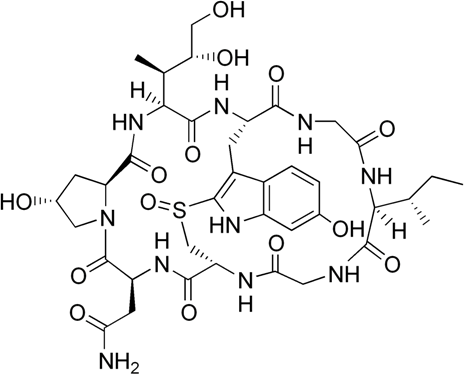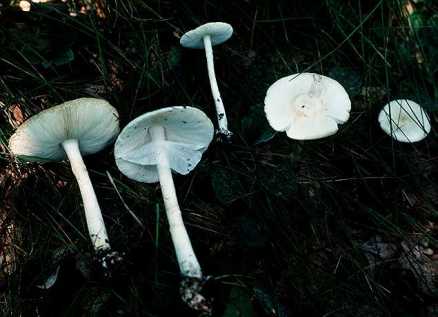Poison of Amanita bisporigera
Amanita
bisporigera produces a toxin known as alpha-amanitin.
Alpha-Amanitin is composed of a protein that consists of eight
amino acids arranged in a cyclic pattern. A.
bisporigera has
other toxins such as Beta-Amanitin, Phalloidin, and Phallacidin.
The toxins are mainly concentrated within the liver, blood cells,
and kidneys.
The toxins from A. bisporigera are so detrimental because they affect the enzyme RNA polymerase, which helps in translocation. Translocation is the step within the central dogma of life that helps in the production of amino acids, which then form proteins. Without these proteins, the liver will start to shut down, and eventually fail. These toxins have also been known to lyse red blood cells and cause severe damage to the kidneys.
Amanita bisporigera
produces one of the deadliest toxins known
within the fungal kingdom. If the toxin is ingested by a human, death is
usually eminent without drastic intervention. The toxin slowly
affects an enzyme in the liver so symptoms usually won’t occur
immediately after ingestion. Symptoms such as vomiting, cramps,
diarrhea, and gastrointestinal pain arise usually after 6-8 hours
post-ingestion. The symptoms will then
last for a certain length
of time before a period of remission occurs. During this period
of remission, the patient can become asymptomatic and may even
feel better. Unfortunately the worst is still
to come. Shortly
after this period, the toxin starts to cause liver failure,
affects the kidneys and the central nervous system. The patient will
then slip into a coma which is followed by death. Other s ymptoms
related to Amanita bisporigera poisoning are:
changes in alertness,
pale complexion, nausea, vomiting, abdominal tenderness, abdominal cramps/pain, diarrhea, higher respiration rate, higher
blood pressure, higher heart rate,etc.
ymptoms
related to Amanita bisporigera poisoning are:
changes in alertness,
pale complexion, nausea, vomiting, abdominal tenderness, abdominal cramps/pain, diarrhea, higher respiration rate, higher
blood pressure, higher heart rate,etc.
The most effective treatment for late stage Amanita bisporigera poisoning, or the ingestion of a large amount of toxin, is through liver transplantation. This has been proven to be only the real effective way to save a patient from death. Early intervention is key. The sooner the patient receives treatment, the greater the chance for survival. However, because symptoms don’t arise right away, and followed by a remission stage, it often is too late before they seek treatment.
If learning about other poisonous fungi interests you here are a few other cool examples: The Deadly Parasol, Aspergillus flavus, and Green Spores Lepiota.
The chemical structure of alpha- amanitin, the main toxin found within Amanita bisporigera
Source: Wikipedia Commons
If you happen to come across one of these while hiking or traveling through the woods, STAY clear from these mushrooms.
Source: Tom Volk Fungi
Continue to learn how this organism interacts with the surrounding environment
